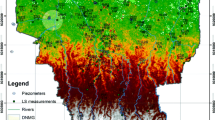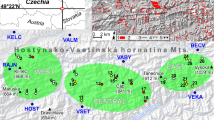Abstract
Taiyuan city has experienced serious land subsidence since the 1950s, with the maximum accumulated subsidence of 2,960 mm and a total affected area of 585 km2 by 2003. Tectonic settlement was found to contribute about 1% and the major cause is over-exploitation of groundwater. The spatial–temporal relationship between the areal distribution of land subsidence and that of groundwater drawdown from 1956 to 2000 indicates that although land subsidence centers overall match groundwater depression cones, there are local deviations, and that although the time series curves are similar, land subsidence always lags behind groundwater level decline, with different lag time at different sites. The major findings of this work on the control of stratigraphic heterogeneity on the spatial pattern of land subsidence at Taiyuan include: (1) land subsidence centers shift from the corresponding groundwater depression cones to the sides with thicker accumulated clay layers; (2) under the same pumping rate, land subsidence at places with more clay interlayers and thinner individual interlayers is greater and the lag time shorter; and (3) land subsidence is closely related to the physical properties of clay soils. The Interbed Storage Package-1, a modular subroutine of MODFLOW was employed to simulate the areal distribution of individual layer compression. The modeling results show that compression of different clay layers has different contribution to land subsidence. Pumping groundwater from water-bearing zones close to the most compressible clay layers should therefore be carefully controlled.















Similar content being viewed by others
References
Andronopoulos B, Rozos D, Hadzinakos I (1991) Subsidence phenomena in the industrial area of Thessaloniki, Greece. In: Johnson AI (ed) Proceedings of the 4th international symposium on land subsidence, vol 200. IAHS Publication, pp 59–70
Balestri M, Villani B (1991) Study of the subsidence in the Bolognese area. In: Johnson AI (ed) Proceedings of the 4th international symposium on land subsidence, vol 200. IAHS Publication, pp 71–80
Bergado DT, Balasubramaniam AS, Apaipong W (1986) Fields monitoring of subsidence effects in AIT campus, Bangkok. In: Johnson AI, Carbognin L, Ubertini L (eds) Proceedings of the 3rd international symposium on land subsidence, vol 151. IAHS Publication, pp 391–404
Carbignin L, Gatto P (1986) An overview of the subsidence of Venice. In: Johnson AI, Carbognin L, Ubertini L (eds) Proceedings of the 3rd international Symposium on land subsidence, vol 151. IAHS Publication, pp 321–328
Dimova V (1996) Some direct and inverse problems in land subsidence theory. Int J Rock Mech Mining Sci Geomech 33(7):331A
Don N C, Araki H, Yamanishi H, Koga K (2005) Simulation of groundwater flow and environmental effects resulting from pumping. Environ Geol 47(3):361–374
Epstein VJ (1987) Hydrologic and geologic factors affecting land subsidence near Eloy, Arizona: U.S. Geological Survey Water-Resources Investigations Report 87–4143, 28 p
Gabrysch RK (2000) Land-surface subsidence and its control in the Houston-Galveston region, Texas, 1906–1995. In: Carbognin L, Gambolati G, Johnson AI (eds) Proceedings of the 6th international symposium on land subsidence, vol 2. Ravenna, Italy, pp 81–92
Guangxiao D, Yiaoqi Z (1986) Land subsidence in China. In: Johnson AI, Carbognin L, Ubertini L (eds) Proceedings of the 3rd international symposium on land subsidence, vol 151. IAHS Publication, pp 405–414
Haryono (1995) Relation between groundwater withdrawal and land subsidence in Kelantan, Malaysia. In: Barends FBJ, Brouwer FJJ, Schröder FH (eds) Proceedings of 5th international symposium on land subsidence, vol 234. IAHS Publication, pp 31–33
Holdahl SR, Zilkoski DB, Holzschuh JC (1991) Subsidence at Houston, Texas, 1973–1987. In: Johnson AI (ed) Proceedings of the 4th international symposium on land subsidence, vol 200I. IAHS Publication, pp 3–14
Holzer TL (1977) Ground failure in areas of subsidence due to ground-water decline in the United States. In: Proceedings of the 2nd international symposium on land subsidence, vol 121. IAHS Publication, pp 423–434
Hu RL, Wang SJ, Lee CF, Li ML (2002) Characteristics and trends of land subsidence in Tanggu, Tianjin, China. Bull Eng Geol Environ 61(3):213–225
Hu RL, Yue ZQ, Wang LC, Wang SJ (2004) Review on current status and challenging issues of land subsidence in China. Eng Geol 76(1):65–77
Inaba Y, Aoki S, Endo T, Kaido R (1970) Reviews of land subsidence researches in Tokyo. In: Tison LJ (ed) Land subsidence/affaissement du sol. vol 88/89. IAHS Publication, pp 87–98
Jacob CE (1940) On the flow of water in an elastic artesian aquifer. Trans Am Geophys Union 21(2):574–586
Jorgensen DG (1980) Relationships between basic soils-engineering equations and basic ground-water flow equations. U.S. Govt. Print. Off., Washington, p 40
Kooi H (2000) Land subsidence due to compaction in the coastal area of the Netherlands: the role of lateral fluid flow and constraints from well-log data. Glob Planet Change 27(4):207–222
Larson KJ, Basagaoglu H, Marino MA (2001) Prediction of optimal safe ground water yield and land subsidence in the Los Banos-Kettleman City area, California, using a calibrated numerical simulation model. J Hydrol 242(1/2):79–102
Leake SA, Prudic DE (1991) Documentation of a computer program to simulate aquifer-system compaction using the modular finite-difference ground-water flow model: U.S. Geological Survey Techniques of Water-Resources Investigations, book 6, chap. A2, 68 p
Lebbe L (1995) Land subsidence due to groundwater withdrawal from the semi-confined aquifers of southwestern Flanders. In: Barends FBJ, Brouwer FJJ, Schröder FH (eds) Proceedings of 5th international symposium on land subsidence, vol 234. IAHS Publication, pp 47–54
Liao JS, Pan KL, Haimson BC (1991) The monitoring and investigation of ground subsidence in Southwest Taiwan. In: Johnson AI (ed) Proceedings of the 4th international symposium on land subsidence, vol 200, IAHS Publication, pp 81–97
Liu CH, Pan YW, Liao JJ, Huang CT, Ouyang S (2004) Characterization of land subsidence in the Choshui River alluvial fan, Taiwan. Environ Geol 45(8):1154–1166
Liu CW, Lin WS, Shang C, Liu SH (2001) The effect of clay dehydration on land subsidence in the Yun-Lin coastal area, Taiwan. Environ Geol 40(4/5):518–527
Longfield TE (1932) The subsidence of London. Ordnance survey, Prof. Papers, new ser., No. 14
McDonald MG, Harbaugh AW (1988) A modular three-dimensional finite-difference ground-water flow model: U.S. Geological Survey Techniques of Water-Resources Investigations, book 6, chap. A1, 548 p
Meinzer OE (1928) Compressibility and elasticity of artesian aquifers. Econ Geol 23(3):263–291
Miyabe N (1970) Directions of research on land subsidence. In: Tison LJ (ed) Land subsidence/affaissement du sol, vol 88/89. IAHS Publication, pp 1–11
Nguyen TQ, Helm DC (1995). Land subsidence due to groundwater withdrawal in Hanoi, Vietnam. In: Barends FBJ, Brouwer FJJ, Schröder FH (eds) Proceedings of 5th international symposium on land subsidence, vol 234. IAHS Publication, pp 55–60
Nunez O, Escojido D (1977) Subsidence in the Bolivar coast. In: Proceedings of the 2nd international symposium on land subsidence, vol 121. IAHS Publication, pp 257–266
Pavelko MT (2004) Estimates of hydraulic properties from a one-dimensional numerical model of vertical aquifer-system deformation, Lorenzi Site, Las Vegas, Nevada: U.S. Geological Survey Water-Resources Investigations Report 03–4083, 36 p
Phien-wej N, Giao PH, Nutalaya P (1998) Field experiment of artificial recharge through a well with reference to land subsidence control. Int J Eng Geol 50(1/2):187–201
Poland JF, Davis GH (1969) Land subsidence due to withdrawals of fluids. In: Varnes DJ, Kiersch G (eds) Geological Society of American Reviews in Engineering Geology, vol 2. pp 187–269
Prokopovich N P (1986) Classification of land subsidence by origin. In: Johnson AI, Carbognin L, Ubertini L (eds) Proceedings of the 3rd international symposium on land subsidence, vol 151. IAHS Publication, pp 281–290
Prokopovich N P (1991) Detection of aquifers susceptibility to land subsidence. In: Johnson AI (ed) Proceedings of the 4th international symposium on land subsidence, vol 200. IAHS Publication, pp 27–34
Rietveld H (1986) Land subsidence in the Netherlands. In: Johnson AI, Carbognin L, Ubertini L (eds) Proceedings of the 3rd international symposium on land subsidence, vol 151. IAHS Publication, pp 455–465
Riley FS (1970) Analysis of borehole extensometer data from central California. In: Tison LJ (ed) Land subsidence/affaissement du sol. vol 88/89. IAHS Publication, pp 423–431
Rojstaczer S, Deverel SJ (1995) Land subsidence in drained histosols and highly organic mineral soils of California. Soil Sci Soc Am J 59(4):1162–1167
Sato HP, Abe K, Ootaki O (2003) GPS-measured land subsidence in Ojiya City, Niigata Prefecture, Japan. Eng Geol 67(3/4):379–390
Sneed M, Paveko MT, Galloway DL (2000) Modeling residual aquifer-system compaction: constraining the vertical hydraulic diffusivity of thick aquitards. In: Carbognin L, Gambolati G, Johnson AI (eds) Proceedings of the 6th international symposium on land subsidence, vol 2. Ravenna, Italy, pp 343–353
Teatini P, Ferronato M, Gambolati G, Bertoni W, Gonella M (2005) A century of land subsidence in Ravenna, Italy. Environ Geol 47(6):831–846
Terzaghi K (1925) Principles of soil mechanics: IV Settlement and consolidation of clay. Eng News Rec 95(3):874–878
Terzaghi K (1943) Theoretical soil mechanics. Wiley, New York, p 510
Xue YQ, Zhang Y, Ye SJ, Li QF (2003) Land subsidence in China and its problems (in Chinese). Quaternary Sci 23(6):585–593
Yamamoto S (1977) Recent trend of land subsidence in Japan. In: Proceedings of the 2nd international symposium on land subsidence. vol 121. IAHS Publication, pp 9–15
Acknowledgments
National Natural Science Foundation of China (40425001), Key Project of Ministry of Education of China (No. 104038) and China Geological Survey (No. CGS-200310400009) financially supported this work.
Author information
Authors and Affiliations
Corresponding author
Rights and permissions
About this article
Cite this article
Ma, R., Wang, Y., Ma, T. et al. The effect of stratigraphic heterogeneity on areal distribution of land subsidence at Taiyuan, northern China. Environ Geol 50, 551–568 (2006). https://doi.org/10.1007/s00254-006-0232-2
Received:
Accepted:
Published:
Issue Date:
DOI: https://doi.org/10.1007/s00254-006-0232-2




